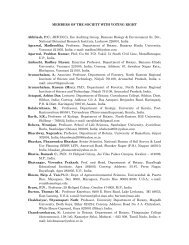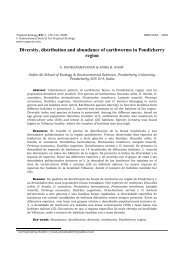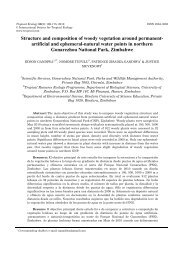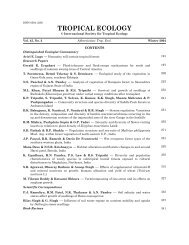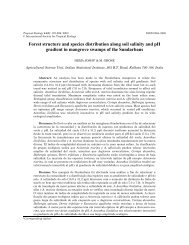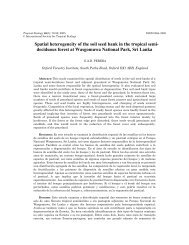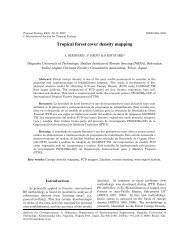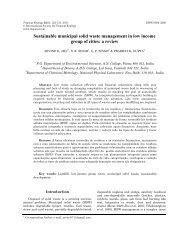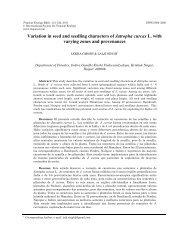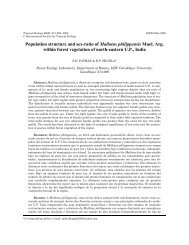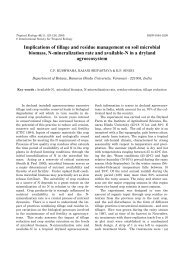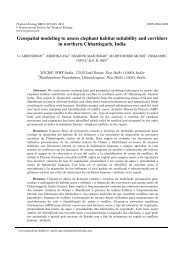The impact of resource collection by local communities on the dry ...
The impact of resource collection by local communities on the dry ...
The impact of resource collection by local communities on the dry ...
Create successful ePaper yourself
Turn your PDF publications into a flip-book with our unique Google optimized e-Paper software.
Tropical Ecology 46(2): 135–143, 2005 ISSN 0564–3295<br />
© Internati<strong>on</strong>al Society for Tropical Ecology<br />
<str<strong>on</strong>g>The</str<strong>on</strong>g> <str<strong>on</strong>g>impact</str<strong>on</strong>g> <str<strong>on</strong>g>of</str<strong>on</strong>g> <str<strong>on</strong>g>resource</str<strong>on</strong>g> <str<strong>on</strong>g>collecti<strong>on</strong></str<strong>on</strong>g> <str<strong>on</strong>g>by</str<strong>on</strong>g> <str<strong>on</strong>g>local</str<strong>on</strong>g> <str<strong>on</strong>g>communities</str<strong>on</strong>g> <strong>on</strong> <strong>the</strong> <strong>dry</strong><br />
forests <str<strong>on</strong>g>of</str<strong>on</strong>g> <strong>the</strong> Kalakad–Mundanthurai Tiger Reserve<br />
M. ARJUNAN 1 , JEAN–PHILIPPE PUYRAVAUD 2 & PRIYA DAVIDAR 1*<br />
1 Department <str<strong>on</strong>g>of</str<strong>on</strong>g> Ecology and Envir<strong>on</strong>mental Sciences, P<strong>on</strong>dicherry University,<br />
Kalapet, P<strong>on</strong>dicherry 605014<br />
2 IT Power India, 8 Romain Rolland St., P<strong>on</strong>dicherry 605 001, India<br />
Abstract: Rural <str<strong>on</strong>g>communities</str<strong>on</strong>g> <str<strong>on</strong>g>of</str<strong>on</strong>g>ten depend <strong>on</strong> forest <str<strong>on</strong>g>resource</str<strong>on</strong>g>s for <strong>the</strong>ir livelihood, but n<strong>on</strong>-sustainable<br />
extracti<strong>on</strong> <str<strong>on</strong>g>of</str<strong>on</strong>g> <strong>the</strong>se <str<strong>on</strong>g>resource</str<strong>on</strong>g>s can result in <strong>the</strong> loss <str<strong>on</strong>g>of</str<strong>on</strong>g> biodiversity. To assess <strong>the</strong> <str<strong>on</strong>g>impact</str<strong>on</strong>g> <str<strong>on</strong>g>of</str<strong>on</strong>g> <str<strong>on</strong>g>resource</str<strong>on</strong>g> extracti<strong>on</strong><br />
<strong>on</strong> forest vegetati<strong>on</strong>, we c<strong>on</strong>ducted a study in <strong>the</strong> <strong>dry</strong> deciduous forests adjoining <strong>the</strong> eastern boundary <str<strong>on</strong>g>of</str<strong>on</strong>g> <strong>the</strong><br />
Kalakad-Mundanthurai Tiger Reserve in <strong>the</strong> sou<strong>the</strong>rn western ghats, India. Using 8, 1–ha plots where all<br />
woody species ≥3.18 cm dbh (diameter at breast height) were permanently marked with tags, we estimated<br />
<strong>the</strong> number <str<strong>on</strong>g>of</str<strong>on</strong>g> fresh cuttings <strong>on</strong> branches and stems at 3–m<strong>on</strong>th intervals over a period <str<strong>on</strong>g>of</str<strong>on</strong>g> 2 years. We used<br />
<strong>the</strong>se data to estimate <strong>the</strong> extracti<strong>on</strong> pressure: [(total number <str<strong>on</strong>g>of</str<strong>on</strong>g> cuts*100/total number <str<strong>on</strong>g>of</str<strong>on</strong>g> plants in <strong>the</strong> plot)/<br />
3] to give m<strong>on</strong>thly percentages for each village. We compared vegetati<strong>on</strong> structure, diversity, basal area and<br />
regenerati<strong>on</strong> in sites with heavy human pressure to c<strong>on</strong>trol plots where <strong>the</strong>re was no current extracti<strong>on</strong>. On<br />
average, branches and stems from 10% <str<strong>on</strong>g>of</str<strong>on</strong>g> plants in a hectare <str<strong>on</strong>g>of</str<strong>on</strong>g> forest were pruned or cut every m<strong>on</strong>th.<br />
However, <strong>the</strong> mean % <str<strong>on</strong>g>of</str<strong>on</strong>g> branches and stems pruned or cut per m<strong>on</strong>th declined from 15% to 8% over <strong>the</strong> 2<br />
year study period. <str<strong>on</strong>g>The</str<strong>on</strong>g>re was lower species richness, species diversity, and mean height <str<strong>on</strong>g>of</str<strong>on</strong>g> trees in <strong>the</strong><br />
disturbed site, when compared with <strong>the</strong> undisturbed sites. <str<strong>on</strong>g>The</str<strong>on</strong>g> basal area and regenerati<strong>on</strong> <str<strong>on</strong>g>of</str<strong>on</strong>g> plants were<br />
also lower in <strong>the</strong> disturbed sites. Very few <str<strong>on</strong>g>of</str<strong>on</strong>g> <strong>the</strong> species extracted <str<strong>on</strong>g>by</str<strong>on</strong>g> villagers regenerated in <strong>the</strong> disturbed<br />
sites. This suggests that <str<strong>on</strong>g>resource</str<strong>on</strong>g> extracti<strong>on</strong> is n<strong>on</strong>-sustainable within <strong>the</strong> protected area and will eventually<br />
lead to loss <str<strong>on</strong>g>of</str<strong>on</strong>g> biodiversity and degradati<strong>on</strong> <str<strong>on</strong>g>of</str<strong>on</strong>g> <strong>the</strong> forest.<br />
Resumen: C<strong>on</strong> frecuencia las comunidades rurales dependen de recursos forestales para su subsistencia,<br />
pero la extracción no sostenible de estos recursos puede provocar la pérdida de biodiversidad. Para evaluar el<br />
<str<strong>on</strong>g>impact</str<strong>on</strong>g>o de la extracción de recursos sobre la vegetación forestal realizamos un estudio en los bosques<br />
tropicales caducifolios adyacentes al límite oriental de la Reserva del Tigre de Kalakad-Mundanthurai, en el<br />
sur de los Gates Occidentales, India. Usando ocho parcelas de 1 ha en las que todas las especies leñosas ≥<br />
3.18 cm dap (diámetro a la altura del pecho) fuer<strong>on</strong> marcadas permanentemente c<strong>on</strong> etiquetas, estimamos el<br />
número de cortes recientes sobre ramas y tr<strong>on</strong>cos a intervalos de tres meses durante un periodo de dos años.<br />
Usamos estos datos para estimar la presión de extracción: (número total de cortes* 100/número total de<br />
plantas en la parcela)/3) para obtener mensualmente porcentajes para cada poblado. Comparamos la<br />
estructura de la vegetación, la diversidad, el área basal y la regeneración en sitios c<strong>on</strong> presión humana<br />
intensa c<strong>on</strong> parcelas c<strong>on</strong>trol sin extracción actual. En promedio, las ramas y los tallos de 10% de las plantas<br />
en una hectárea de bosque fuer<strong>on</strong> podados o cortados cada mes. Sin embargo, las ramas y los tallos podados o<br />
cortados por mes declinar<strong>on</strong> de 15% a 8% durante los dos años de estudio. Hubo decrementos en la riqueza de<br />
especies, la diversidad de especies y la altura media de los árboles en el sitio perturbado en comparación c<strong>on</strong><br />
los sitios no perturbados, y el área basal y la regeneración de plantas también fuer<strong>on</strong> menores. Muy pocas de<br />
las especies extraídas por los aldeanos mostrar<strong>on</strong> regeneración en los sitios perturbados. Esto sugiere que la<br />
extracción de recursos no es sostenible en el interior del área protegida y a la larga c<strong>on</strong>ducirá a la pérdida de<br />
biodiversidad y la degradación del bosque.<br />
Resumo: As comunidades rurais dependem muitas vezes dos recursos florestais para os seus meios de<br />
subsistência mas a extracção não sustentável destes recursos podem c<strong>on</strong>duzir a uma perda de biodiversidade.<br />
Para avaliar o <str<strong>on</strong>g>impact</str<strong>on</strong>g>o da extracção destes recursos na vegetação florestal, c<strong>on</strong>duzimos um estudo na floresta<br />
seca caducifólia adjacente à fr<strong>on</strong>teira leste da Reserva de Kaçakad-Mundanthurai Tiger na z<strong>on</strong>a meridi<strong>on</strong>al<br />
ocidental dos ghats, na Índia. Usando 8 parcelas de 1 ha todas as espécies lenhosas com DAP (diâmetro à<br />
* Corresp<strong>on</strong>ding Author
136<br />
RESOURCE EXTRACTION AND FOREST VEGETATION<br />
altura do peito) ≥ a 3,18 cm foram permanentemente marcadas com tarjetas tendo-se estimado o número de<br />
rebentos novos nos ramos e tr<strong>on</strong>cos em intervalos de 3 meses durante um período de 2 anos. Estes dados<br />
foram utilizados para estimar a pressão de extracção: ((número total de cortes*100/número total de plantas<br />
na parcela)/3) para obtenção das percentagens mensais para cada aldeia. A estrutura da vegetação, a<br />
diversidade, a área basal e a regeneração nas estações com pressões humanas fortes foi comparada com<br />
parcelas c<strong>on</strong>trolo <strong>on</strong>de não se verificava extracção. Em média, os ramos e tr<strong>on</strong>cos de 10% das plantas num<br />
hectare de floresta foram podados ou cortados em cada mês. C<strong>on</strong>tudo, os ramos e tr<strong>on</strong>cos podados ou cortados<br />
por mês declinou de 15% a 8% durante os dois anos do período de estudo. Verificou-se igualmente um<br />
decréscimo da riqueza específica, da diversidade e da altura média das árvores nas estações disturbadas em<br />
comparação com as estações não disturbadas. Verificou-se, também, que a área basal e a regeneração das<br />
plantas foi menor. Muito poucas espécies extraídas pelos camp<strong>on</strong>eses regeneraram nas estações disturbadas.<br />
Isto parece sugerir que a extracção de recursos não é sustentável dentro das áreas protegidas e que<br />
eventualmente c<strong>on</strong>duzirá a uma perda de biodiversidade e degradação das florestas.<br />
Key words: Forest <str<strong>on</strong>g>resource</str<strong>on</strong>g>s, India, Kalakad–Mundanthurai Tiger Reserve, protected areas, rural<br />
<str<strong>on</strong>g>communities</str<strong>on</strong>g>, sustainable extracti<strong>on</strong>, Western ghats.<br />
Introducti<strong>on</strong><br />
Forests have provided a livelihood for rural<br />
populati<strong>on</strong>s in India over <strong>the</strong> ages and many<br />
plant species are used <str<strong>on</strong>g>by</str<strong>on</strong>g> <str<strong>on</strong>g>local</str<strong>on</strong>g> <str<strong>on</strong>g>communities</str<strong>on</strong>g> for<br />
<strong>the</strong>ir domestic needs. For example, about 124<br />
plant species were used <str<strong>on</strong>g>by</str<strong>on</strong>g> <strong>the</strong> people living<br />
around <strong>the</strong> forest area <str<strong>on</strong>g>of</str<strong>on</strong>g> <strong>the</strong> Madhya Pradesh for<br />
fuel wood, fodder and for medicinal purpose<br />
(Purushothaman et al. 2000). However, due to <strong>the</strong><br />
increase in populati<strong>on</strong> density, <strong>the</strong> harvesting <str<strong>on</strong>g>of</str<strong>on</strong>g><br />
<strong>the</strong>se products is no l<strong>on</strong>ger sustainable in many<br />
areas. Over-harvesting <str<strong>on</strong>g>of</str<strong>on</strong>g> forest products in a<br />
n<strong>on</strong>-sustainable manner has had a drastic effect<br />
<strong>on</strong> <strong>the</strong> forest ecosystems in India (Anitha et al.<br />
2003; Rai & Chakrabarti 2001). Species diversity<br />
and stem densities and <strong>the</strong> regenerati<strong>on</strong> <str<strong>on</strong>g>of</str<strong>on</strong>g> target<br />
species were lower in heavily <str<strong>on</strong>g>impact</str<strong>on</strong>g>ed forests<br />
(Murali & Hegde 1996; Murali et al. 1996; Sekar<br />
1999; Shanker et al. 1998) and this has resulted<br />
in <strong>the</strong> degradati<strong>on</strong> <str<strong>on</strong>g>of</str<strong>on</strong>g> <strong>the</strong> forest and loss <str<strong>on</strong>g>of</str<strong>on</strong>g> forest<br />
cover and biodiversity (Garrigues 1999;<br />
Pouchepadass & Puyravaud 2002; Silori &<br />
Mishra 2001).<br />
Understanding <strong>the</strong> processes <str<strong>on</strong>g>of</str<strong>on</strong>g> forest degradati<strong>on</strong><br />
is very important for <strong>the</strong> c<strong>on</strong>servati<strong>on</strong> and<br />
management <str<strong>on</strong>g>of</str<strong>on</strong>g> biodiversity. In this paper, we<br />
undertook a study <str<strong>on</strong>g>of</str<strong>on</strong>g> <strong>the</strong> effect <str<strong>on</strong>g>of</str<strong>on</strong>g> <str<strong>on</strong>g>resource</str<strong>on</strong>g><br />
extracti<strong>on</strong> <strong>on</strong> <strong>the</strong> vegetati<strong>on</strong> in <strong>the</strong> Kalakad-<br />
Mundanthurai Tiger Reserve (KMTR), <strong>the</strong><br />
sou<strong>the</strong>rnmost Project Tiger Reserve in India<br />
located in <strong>the</strong> western ghats. KMTR harbors high<br />
levels <str<strong>on</strong>g>of</str<strong>on</strong>g> plant and animal diversity, but is facing<br />
increasing anthropogenic pressure from <strong>the</strong><br />
villages located al<strong>on</strong>g its eastern boundary in<br />
terms <str<strong>on</strong>g>of</str<strong>on</strong>g> cutting and removal <str<strong>on</strong>g>of</str<strong>on</strong>g> fuel wood, small<br />
and large timber, <str<strong>on</strong>g>collecti<strong>on</strong></str<strong>on</strong>g> <str<strong>on</strong>g>of</str<strong>on</strong>g> fodder and leaves<br />
as organic fertilizers for fields and occasi<strong>on</strong>al<br />
poaching <str<strong>on</strong>g>of</str<strong>on</strong>g> animals. <str<strong>on</strong>g>The</str<strong>on</strong>g> foothills <str<strong>on</strong>g>of</str<strong>on</strong>g> KMTR<br />
neighboring <strong>the</strong> villages are covered with<br />
degraded thorn forest and <strong>dry</strong> deciduous forests<br />
up to an elevati<strong>on</strong> <str<strong>on</strong>g>of</str<strong>on</strong>g> about 200 m. About 145<br />
villages near <strong>the</strong> forest boundary are composed <str<strong>on</strong>g>of</str<strong>on</strong>g><br />
a large number <str<strong>on</strong>g>of</str<strong>on</strong>g> low-income households. <str<strong>on</strong>g>The</str<strong>on</strong>g>se<br />
villages maintain about 10,000 cattle that <str<strong>on</strong>g>of</str<strong>on</strong>g>ten<br />
graze in <strong>the</strong> forest and cause <strong>the</strong> degradati<strong>on</strong> <str<strong>on</strong>g>of</str<strong>on</strong>g><br />
foothill forests in <strong>the</strong> buffer z<strong>on</strong>e <str<strong>on</strong>g>of</str<strong>on</strong>g> <strong>the</strong> KMTR<br />
(Dutt 2001).<br />
A World Bank funded eco-development program<br />
was launched in December 1994 am<strong>on</strong>g <strong>the</strong><br />
villages al<strong>on</strong>g <strong>the</strong> eastern boundary <str<strong>on</strong>g>of</str<strong>on</strong>g> KMTR.<br />
This five-year project (1994–1999) which was<br />
extended for two more years (1999–2001) had <strong>the</strong><br />
objective <str<strong>on</strong>g>of</str<strong>on</strong>g> reducing forest dependency am<strong>on</strong>g<br />
<strong>the</strong> <str<strong>on</strong>g>local</str<strong>on</strong>g> <str<strong>on</strong>g>communities</str<strong>on</strong>g> and <strong>the</strong>re<str<strong>on</strong>g>by</str<strong>on</strong>g> providing<br />
<strong>the</strong>m with alternative livelihoods. An added<br />
benefit <str<strong>on</strong>g>of</str<strong>on</strong>g> this would be <strong>the</strong> improvement <str<strong>on</strong>g>of</str<strong>on</strong>g> <strong>the</strong><br />
habitat for wildlife.<br />
This study investigated <strong>the</strong> disturbed and<br />
undisturbed <strong>dry</strong> forest near <strong>the</strong>se villages to<br />
assess mean extracti<strong>on</strong> pressure, <strong>the</strong> percentage<br />
<str<strong>on</strong>g>of</str<strong>on</strong>g> stems removed over a fixed period <str<strong>on</strong>g>of</str<strong>on</strong>g> time. We<br />
compared <strong>the</strong> effect <str<strong>on</strong>g>of</str<strong>on</strong>g> <str<strong>on</strong>g>resource</str<strong>on</strong>g> extracti<strong>on</strong> <strong>on</strong><br />
plant species richness, plant density, basal area<br />
and regenerati<strong>on</strong> in disturbed and undisturbed<br />
<strong>dry</strong> forests.<br />
Study area<br />
Kalakad–Mundanthurai Tiger Reserve is<br />
situated in <strong>the</strong> sou<strong>the</strong>rn western ghats regi<strong>on</strong> (8°<br />
25′ to 8° 53′ N latitude and 77° 10′ to 77° 35′ E<br />
l<strong>on</strong>gitude) and is bounded <strong>on</strong> <strong>the</strong> eastern and<br />
sou<strong>the</strong>rn sides <str<strong>on</strong>g>by</str<strong>on</strong>g> Tirunelveli and Kanyakumari<br />
districts <str<strong>on</strong>g>of</str<strong>on</strong>g> Tamil Nadu and <strong>on</strong> <strong>the</strong> western side<br />
<str<strong>on</strong>g>by</str<strong>on</strong>g> Kerala state. <str<strong>on</strong>g>The</str<strong>on</strong>g> Reserve covers a total area<br />
<str<strong>on</strong>g>of</str<strong>on</strong>g> 895 km 2 , <str<strong>on</strong>g>of</str<strong>on</strong>g> which 537 km 2 is in <strong>the</strong> core z<strong>on</strong>e<br />
(Fig. 1). It was created out <str<strong>on</strong>g>of</str<strong>on</strong>g> <strong>the</strong> Mundanthurai
Mean rainfall (mm)<br />
250<br />
200<br />
150<br />
100<br />
50<br />
0<br />
INDIA<br />
Western<br />
Ghats<br />
KERALA<br />
BAY OF<br />
BENGAL<br />
SRI LANKA<br />
KALAKAD-MUNDANTHURAI TIGER RESERVE<br />
ANAVANKUDIERUPPU<br />
VEMBAYAPURAM<br />
MUNDANTHURAI<br />
KALAKAD<br />
TAMILNADU<br />
J F M A M J J A S O N D<br />
M<strong>on</strong>ths<br />
VADAMALAISAMUTHRAM<br />
AGASTHIYAPURAM<br />
ALADIYUR<br />
MANJUVELAI<br />
MUNGILADI<br />
KALAKAD<br />
EARMALPURAM<br />
POOTHATHANKUDIERUPPU<br />
VADAGARAI<br />
CHIDAMBARAPURAM<br />
Fig. 1. Map <str<strong>on</strong>g>of</str<strong>on</strong>g> <strong>the</strong> study area showing <strong>the</strong> Kalakad–<br />
Mundanthurai Tiger Reserve and <strong>the</strong> study villages.<br />
Approximate scale 2 mm = 1 km.<br />
Fig. 2. Mean m<strong>on</strong>thly rainfall recorded in Servalar,<br />
≈10 km from <strong>the</strong> study regi<strong>on</strong>, for a period <str<strong>on</strong>g>of</str<strong>on</strong>g> 9 years<br />
from 1994 to 2002.<br />
and Kalakad Wildlife Sanctuaries in <strong>the</strong> early<br />
90’s to provide protecti<strong>on</strong> to declining populati<strong>on</strong>s<br />
<str<strong>on</strong>g>of</str<strong>on</strong>g> <strong>the</strong> Tiger (Pan<strong>the</strong>ra tigris).<br />
<str<strong>on</strong>g>The</str<strong>on</strong>g> eastern boundary <str<strong>on</strong>g>of</str<strong>on</strong>g> <strong>the</strong> reserve has 145<br />
villages/hamlets comprising about 30,000<br />
households located within 5 km <str<strong>on</strong>g>of</str<strong>on</strong>g> <strong>the</strong> boundary<br />
(Melkani 2001). Most villages have sandy loam<br />
red soils, which retain water for a l<strong>on</strong>g period and<br />
are suitable for <strong>the</strong> cultivati<strong>on</strong> <str<strong>on</strong>g>of</str<strong>on</strong>g> rice, banana and<br />
vegetable crops.<br />
Due to its topographical diversity and<br />
altitudinal range, KMTR has diverse forest types<br />
from thorny dense mixed scrub vegetati<strong>on</strong> to rain<br />
forests. <str<strong>on</strong>g>The</str<strong>on</strong>g> foothills are clo<strong>the</strong>d with <strong>dry</strong> thorny<br />
forest, <strong>dry</strong> deciduous forest and overgrown teak<br />
plantati<strong>on</strong>s. <str<strong>on</strong>g>The</str<strong>on</strong>g> <str<strong>on</strong>g>local</str<strong>on</strong>g> community has utilized<br />
this forest over <strong>the</strong> historical period for grazing,<br />
hunting and <str<strong>on</strong>g>collecti<strong>on</strong></str<strong>on</strong>g> <str<strong>on</strong>g>of</str<strong>on</strong>g> forest products (Arjunan<br />
2004), but human pressure <strong>on</strong> <strong>the</strong> forests has<br />
probably increased over <strong>the</strong> past 50 years due to<br />
increasing populati<strong>on</strong> densities.<br />
Mean annual rainfall in Servalar, ≈10 km<br />
from <strong>the</strong> study site with similar climate, over a 9–<br />
year period, from 1994 to 2002, was 716 mm. <str<strong>on</strong>g>The</str<strong>on</strong>g><br />
<strong>dry</strong> seas<strong>on</strong> extended from January to October<br />
ARJUNAN et al.<br />
137<br />
(Fig. 2). Rainfall from <strong>the</strong> nor<strong>the</strong>ast m<strong>on</strong>so<strong>on</strong> fell<br />
mostly during November–December.<br />
Materials and methods<br />
Two different aspects <str<strong>on</strong>g>of</str<strong>on</strong>g> <str<strong>on</strong>g>resource</str<strong>on</strong>g> extracti<strong>on</strong><br />
were studied. <str<strong>on</strong>g>The</str<strong>on</strong>g> first was <strong>the</strong> quantificati<strong>on</strong> <str<strong>on</strong>g>of</str<strong>on</strong>g><br />
extracti<strong>on</strong> pressure <str<strong>on</strong>g>by</str<strong>on</strong>g> assessment <str<strong>on</strong>g>of</str<strong>on</strong>g> <strong>the</strong> number<br />
<str<strong>on</strong>g>of</str<strong>on</strong>g> new pruning or cuts <strong>on</strong> all plants ≥3.18 cm dbh<br />
(diameter at breast height), including lianas.<br />
<str<strong>on</strong>g>The</str<strong>on</strong>g>se new cuts <strong>on</strong> plants were assessed at 3–<br />
m<strong>on</strong>th intervals over a period <str<strong>on</strong>g>of</str<strong>on</strong>g> 2 years using<br />
permanent plots. <str<strong>on</strong>g>The</str<strong>on</strong>g> sec<strong>on</strong>d aspect was <strong>the</strong> effect<br />
<str<strong>on</strong>g>of</str<strong>on</strong>g> <str<strong>on</strong>g>resource</str<strong>on</strong>g> extracti<strong>on</strong> <strong>on</strong> plant density, mean<br />
height, basal area and regenerati<strong>on</strong>. For <strong>the</strong>se<br />
two studies different sets <str<strong>on</strong>g>of</str<strong>on</strong>g> plots were used.<br />
Estimates <str<strong>on</strong>g>of</str<strong>on</strong>g> extracti<strong>on</strong> pressure<br />
To assess <strong>the</strong> extracti<strong>on</strong> pressure <strong>on</strong> <strong>the</strong><br />
forest, eight square plots each measuring 1 ha<br />
were laid out in March 2000 in <strong>the</strong> forests<br />
frequented <str<strong>on</strong>g>by</str<strong>on</strong>g> villagers for collecting fuel wood<br />
and o<strong>the</strong>r forest products. Each <str<strong>on</strong>g>of</str<strong>on</strong>g> <strong>the</strong>se plots was<br />
adjacent to a village and <strong>the</strong>refore <strong>the</strong> extracti<strong>on</strong><br />
pressure <str<strong>on</strong>g>of</str<strong>on</strong>g> 8 villages was estimated. All woody<br />
plant species ≥3.18 cm dbh and woody lianas were<br />
tagged in each 1–ha plot. <str<strong>on</strong>g>The</str<strong>on</strong>g> number <str<strong>on</strong>g>of</str<strong>on</strong>g> cut<br />
stems and branches <strong>on</strong> all standing stems ≥3.18<br />
cm dbh was recorded every 3 m<strong>on</strong>ths in each plot<br />
over a period <str<strong>on</strong>g>of</str<strong>on</strong>g> 2 years from May 2000 to<br />
February 2002. An index <str<strong>on</strong>g>of</str<strong>on</strong>g> extracti<strong>on</strong> pressure<br />
was formulated based <strong>on</strong> <strong>the</strong> number <str<strong>on</strong>g>of</str<strong>on</strong>g> cut stems<br />
and branches <strong>on</strong> all <strong>the</strong> tagged plants in a plot.<br />
<str<strong>on</strong>g>The</str<strong>on</strong>g> removal <str<strong>on</strong>g>of</str<strong>on</strong>g> plants and plant parts was<br />
recorded. Extracti<strong>on</strong> pressure was given as <strong>the</strong><br />
[(total number <str<strong>on</strong>g>of</str<strong>on</strong>g> cuts*100/total number <str<strong>on</strong>g>of</str<strong>on</strong>g> plants<br />
in <strong>the</strong> plot)/ 3] to give m<strong>on</strong>thly percentages for<br />
each village. <str<strong>on</strong>g>The</str<strong>on</strong>g> mean for each village over <strong>the</strong><br />
2–year period was used as <strong>the</strong> mean m<strong>on</strong>thly<br />
extracti<strong>on</strong> pressure per village, and <strong>the</strong> overall<br />
mean for all villages during a 3–m<strong>on</strong>th period<br />
was <strong>the</strong> mean extracti<strong>on</strong> pressure given in<br />
m<strong>on</strong>ths for that periodic interval. <str<strong>on</strong>g>The</str<strong>on</strong>g> extracti<strong>on</strong><br />
pressure at <strong>the</strong> beginning <str<strong>on</strong>g>of</str<strong>on</strong>g> <strong>the</strong> study and during<br />
<strong>the</strong> last sample period were compared using a n<strong>on</strong><br />
parametric Wilcox<strong>on</strong> signed rank test.<br />
Socio-ec<strong>on</strong>omic correlates <str<strong>on</strong>g>of</str<strong>on</strong>g> extracti<strong>on</strong><br />
pressure<br />
Mean extracti<strong>on</strong> pressure for each village was<br />
correlated with <strong>the</strong> number <str<strong>on</strong>g>of</str<strong>on</strong>g> households in that<br />
village as an indicator <str<strong>on</strong>g>of</str<strong>on</strong>g> village size. <str<strong>on</strong>g>The</str<strong>on</strong>g> number<br />
<str<strong>on</strong>g>of</str<strong>on</strong>g> households increases with village size and<br />
households are <strong>the</strong> basic unit that is involved in<br />
<str<strong>on</strong>g>resource</str<strong>on</strong>g> extracti<strong>on</strong>. <str<strong>on</strong>g>The</str<strong>on</strong>g> village statistics were<br />
obtained from <strong>the</strong> <str<strong>on</strong>g>of</str<strong>on</strong>g>fice <str<strong>on</strong>g>of</str<strong>on</strong>g> <strong>the</strong> Village<br />
Administrati<strong>on</strong> Officer. Comparis<strong>on</strong> <str<strong>on</strong>g>of</str<strong>on</strong>g> extracti<strong>on</strong>
138<br />
RESOURCE EXTRACTION AND FOREST VEGETATION<br />
Table 1. <str<strong>on</strong>g>The</str<strong>on</strong>g> number <str<strong>on</strong>g>of</str<strong>on</strong>g> households per village and mean m<strong>on</strong>thly extracti<strong>on</strong> pressure*.<br />
Village name<br />
Village size<br />
(total<br />
households)<br />
Plant density ha –1<br />
at beginning <str<strong>on</strong>g>of</str<strong>on</strong>g><br />
study<br />
Agasthiyapuram 336 311 8.37<br />
Anavankudieruppu 282 298 8.63<br />
Chidambarapuram 1102 347 8.36<br />
Mean m<strong>on</strong>thly<br />
extracti<strong>on</strong> pressure* (%)<br />
Earmalpuram 804 328 7.25<br />
Manjuvelai 338 352 11.16<br />
Mungiladi 414 346 12.97<br />
Puthathankudieruppu 206 362 12.84<br />
Thirupathiyapuram 110 277 12.80<br />
* % <str<strong>on</strong>g>of</str<strong>on</strong>g> cuts every m<strong>on</strong>th <strong>on</strong> tagged plants.<br />
pressure <str<strong>on</strong>g>by</str<strong>on</strong>g> villages with <strong>the</strong> highest and lowest<br />
mean extracti<strong>on</strong> over <strong>the</strong> 3–m<strong>on</strong>th period was<br />
made using a n<strong>on</strong> parametric Wilcox<strong>on</strong> signed<br />
rank test.<br />
Selecti<strong>on</strong> <str<strong>on</strong>g>of</str<strong>on</strong>g> plots for vegetati<strong>on</strong> analysis<br />
Ano<strong>the</strong>r set <str<strong>on</strong>g>of</str<strong>on</strong>g> plots was used to assess <strong>the</strong><br />
<str<strong>on</strong>g>impact</str<strong>on</strong>g> <str<strong>on</strong>g>of</str<strong>on</strong>g> human disturbance <strong>on</strong> plant species<br />
richness, plant density and basal area. Ten 30 x<br />
30 m plots and <strong>on</strong>e 20 x 50 m plot, totaling an<br />
area <str<strong>on</strong>g>of</str<strong>on</strong>g> <strong>on</strong>e hectare, were randomly laid out in<br />
forest areas adjoining Mundanthurai, where <strong>the</strong><br />
<str<strong>on</strong>g>local</str<strong>on</strong>g> people spent over 3 hours per day in<br />
<str<strong>on</strong>g>collecti<strong>on</strong></str<strong>on</strong>g> <str<strong>on</strong>g>of</str<strong>on</strong>g> fuel wood and o<strong>the</strong>r forest products.<br />
A similar set <str<strong>on</strong>g>of</str<strong>on</strong>g> plots <str<strong>on</strong>g>of</str<strong>on</strong>g> <strong>the</strong> same dimensi<strong>on</strong>s,<br />
totaling to <strong>on</strong>e hectare, were laid out in forested<br />
sites adjoining villages in Kalakad. All study<br />
villages were located adjacent to <strong>the</strong>se two towns<br />
which are in different administrative ranges <str<strong>on</strong>g>of</str<strong>on</strong>g><br />
<strong>the</strong> Forest Department. All stems over ≥3.18 cm<br />
dbh were inventoried, <strong>the</strong>ir dbh and height<br />
recorded. <str<strong>on</strong>g>The</str<strong>on</strong>g> number <str<strong>on</strong>g>of</str<strong>on</strong>g> saplings <str<strong>on</strong>g>of</str<strong>on</strong>g> each species<br />
Ex tra cti<strong>on</strong> pre ssure (%)<br />
18<br />
16<br />
14<br />
12<br />
10<br />
8<br />
6<br />
4<br />
2<br />
0<br />
May-00<br />
Jul-00<br />
Sep-00<br />
Nov-00<br />
Jan-01<br />
Mar-01<br />
May-01<br />
Jul-01<br />
Sep-01<br />
Nov-01<br />
Jan-02<br />
Fig. 3. <str<strong>on</strong>g>The</str<strong>on</strong>g> mean % <str<strong>on</strong>g>of</str<strong>on</strong>g> stems cut over 3–m<strong>on</strong>th<br />
intervals from May 2000 until January 2002.<br />
was counted in 10 x 10 m sub-plots. Saplings<br />
were those plants that were >50 cm in height and<br />
Table 2. Number <str<strong>on</strong>g>of</str<strong>on</strong>g> tree, shrub and liana<br />
species in <strong>the</strong> disturbed and undisturbed sites.<br />
Site descripti<strong>on</strong><br />
Number <str<strong>on</strong>g>of</str<strong>on</strong>g> species<br />
Tree Shrub Liana<br />
<str<strong>on</strong>g>The</str<strong>on</strong>g> mean m<strong>on</strong>thly extracti<strong>on</strong> pressure for<br />
each village was negatively correlated with<br />
village size (r= –63, p
140<br />
RESOURCE EXTRACTION AND FOREST VEGETATION<br />
Table 4. Stem densities <str<strong>on</strong>g>of</str<strong>on</strong>g> adults ≥3.18 cm dbh and saplings
stem densities, species diversity and basal area<br />
than in moderately disturbed sites in <strong>the</strong> same<br />
area (Murali & Hegde 1996; Shanker et al. 1998).<br />
Our study supports <strong>the</strong>se findings and we<br />
show that unregulated <str<strong>on</strong>g>resource</str<strong>on</strong>g> extracti<strong>on</strong> has an<br />
adverse <str<strong>on</strong>g>impact</str<strong>on</strong>g> <strong>on</strong> <strong>the</strong> forest structure, diversity<br />
and regenerati<strong>on</strong>. Species such as Commiphora<br />
caudata that were not used <str<strong>on</strong>g>by</str<strong>on</strong>g> <strong>the</strong> <str<strong>on</strong>g>local</str<strong>on</strong>g> people<br />
occurred at high densities and regenerated well.<br />
Rarely are whole plants cut. Branches <str<strong>on</strong>g>of</str<strong>on</strong>g> all sizes<br />
are removed first and after all <strong>the</strong> branches have<br />
been removed <strong>the</strong> standing stem is cut <strong>the</strong>re<str<strong>on</strong>g>by</str<strong>on</strong>g><br />
destroying <strong>the</strong> plant. <str<strong>on</strong>g>The</str<strong>on</strong>g>refore, <strong>the</strong> number <str<strong>on</strong>g>of</str<strong>on</strong>g><br />
plants decreases more slowly than <strong>the</strong> number <str<strong>on</strong>g>of</str<strong>on</strong>g><br />
branches. Forest degradati<strong>on</strong> is an <strong>on</strong>going<br />
process and <strong>the</strong> World Bank funded ecodevelopment<br />
project in <strong>the</strong> Kalakad-<br />
Mundanthurai Tiger Reserve seems not to have<br />
effectively addressed this problem.<br />
Although levels <str<strong>on</strong>g>of</str<strong>on</strong>g> extracti<strong>on</strong> decreased <str<strong>on</strong>g>by</str<strong>on</strong>g><br />
20% from 2000 to 2002, an average <str<strong>on</strong>g>of</str<strong>on</strong>g> 66 stems<br />
per plot over <strong>the</strong> 2 year study period, <strong>the</strong> current<br />
levels <str<strong>on</strong>g>of</str<strong>on</strong>g> <str<strong>on</strong>g>resource</str<strong>on</strong>g> extracti<strong>on</strong> are clearly n<strong>on</strong>sustainable<br />
(Arjunan 2004). Larger villages,<br />
counter-intuitively have a lower <str<strong>on</strong>g>impact</str<strong>on</strong>g> <strong>on</strong> <strong>the</strong><br />
forest than smaller villages. This might be<br />
because larger villages could have a more<br />
diversified ec<strong>on</strong>omy that is less dependent <strong>on</strong><br />
forest <str<strong>on</strong>g>resource</str<strong>on</strong>g>s than smaller villages.<br />
Of <strong>the</strong> 52 species used <str<strong>on</strong>g>by</str<strong>on</strong>g> <strong>the</strong> <str<strong>on</strong>g>local</str<strong>on</strong>g> populati<strong>on</strong><br />
for different purposes, <strong>the</strong> majority (35: 67%)<br />
were for fuel wood and 14 species for fodder.<br />
About 75% <str<strong>on</strong>g>of</str<strong>on</strong>g> households in developing countries<br />
use fuel-wood for domestic purposes (Desai 1991).<br />
Rural areas in India account for about 85% <str<strong>on</strong>g>of</str<strong>on</strong>g> <strong>the</strong><br />
total fuel wood c<strong>on</strong>sumpti<strong>on</strong> and a large porti<strong>on</strong><br />
<str<strong>on</strong>g>of</str<strong>on</strong>g> <strong>the</strong> rural energy demand is met from <strong>the</strong><br />
<str<strong>on</strong>g>local</str<strong>on</strong>g>ly available fuel wood, cow dung and<br />
agricultural residues (Natarajan 1997). About<br />
62% is from forest sources (Leach 1987).<br />
Fuel-wood extracti<strong>on</strong> was <strong>the</strong> biggest cause <str<strong>on</strong>g>of</str<strong>on</strong>g><br />
forest degradati<strong>on</strong> in <strong>the</strong> buffer z<strong>on</strong>e <str<strong>on</strong>g>of</str<strong>on</strong>g> <strong>the</strong> park.<br />
All segments <str<strong>on</strong>g>of</str<strong>on</strong>g> <strong>the</strong> <str<strong>on</strong>g>local</str<strong>on</strong>g> villages, both <strong>the</strong> poor<br />
daily wage earners and <strong>the</strong> wealthy landowners<br />
depend <strong>on</strong> fuel-wood collected from <strong>the</strong> forest<br />
(Arjunan 2004). With <strong>the</strong> current levels <str<strong>on</strong>g>of</str<strong>on</strong>g><br />
extracti<strong>on</strong>, <strong>the</strong> forest areas will become increasingly<br />
degraded.<br />
Fast growing trees can be planted to provide a<br />
regular source <str<strong>on</strong>g>of</str<strong>on</strong>g> fuel-wood and <strong>the</strong>re<str<strong>on</strong>g>by</str<strong>on</strong>g> reduce<br />
pressure <strong>on</strong> natural forests (Patel 1985). A<br />
restorati<strong>on</strong> program can be initiated in <strong>the</strong><br />
degraded <strong>dry</strong> forests adjoining KMTR. Some kind<br />
<str<strong>on</strong>g>of</str<strong>on</strong>g> a rotati<strong>on</strong>al restorati<strong>on</strong> using fast growing<br />
species as well as species used <str<strong>on</strong>g>by</str<strong>on</strong>g> <strong>the</strong> <str<strong>on</strong>g>local</str<strong>on</strong>g><br />
<str<strong>on</strong>g>communities</str<strong>on</strong>g> can be carried out and sites targeted<br />
for restorati<strong>on</strong> should be protected from human<br />
ARJUNAN et al.<br />
Table 5. Number <str<strong>on</strong>g>of</str<strong>on</strong>g> species used for different<br />
purposes <str<strong>on</strong>g>by</str<strong>on</strong>g> <strong>the</strong> <str<strong>on</strong>g>local</str<strong>on</strong>g> <str<strong>on</strong>g>communities</str<strong>on</strong>g>.<br />
141<br />
Plant<br />
parts used<br />
Number <str<strong>on</strong>g>of</str<strong>on</strong>g><br />
species in use Uses<br />
Wood 35 Fuel wood and implements<br />
Leaf 18 Livestock fodder, green<br />
leaves as fertilizer<br />
Bark 6 Rope and medicine<br />
Fruit 1 Food<br />
Stem 1 Rope<br />
<str<strong>on</strong>g>impact</str<strong>on</strong>g> and livestock grazing until <strong>the</strong>y are selfsustaining.<br />
Unless <strong>the</strong>re is managed extracti<strong>on</strong><br />
regulated at <strong>the</strong> village level, <strong>the</strong> extent <str<strong>on</strong>g>of</str<strong>on</strong>g><br />
degraded forest and wasteland will encroach into<br />
KMTR and <strong>the</strong> envir<strong>on</strong>mental services that<br />
healthy ecosystems provide will be negatively<br />
<str<strong>on</strong>g>impact</str<strong>on</strong>g>ed.<br />
Acknowledgements<br />
We are grateful to Dr. K. S. Bawa for<br />
supporting this project through funds provided <str<strong>on</strong>g>by</str<strong>on</strong>g><br />
a MacArthur Foundati<strong>on</strong> grant. Comments <str<strong>on</strong>g>by</str<strong>on</strong>g><br />
an<strong>on</strong>ymous reviewers greatly improved <strong>the</strong><br />
quality <str<strong>on</strong>g>of</str<strong>on</strong>g> this manuscript. We thank <strong>the</strong> Field<br />
Director <str<strong>on</strong>g>of</str<strong>on</strong>g> <strong>the</strong> Kalakad–Mundanthurai Tiger<br />
Reserve for logistical support.<br />
References<br />
Anitha V., P.K. Muraleetharan & A.S. Binilkumar.<br />
2003. Natural <str<strong>on</strong>g>resource</str<strong>on</strong>g> depleti<strong>on</strong> in protected<br />
areas: Socio ec<strong>on</strong>omic linkages. Indian Journal <str<strong>on</strong>g>of</str<strong>on</strong>g><br />
Social Development 3: 44–59.<br />
Arjunan, M. 2004. Protected Areas and People: A Case<br />
Study <str<strong>on</strong>g>of</str<strong>on</strong>g> Forest Resource Use and Human Impact<br />
in <strong>the</strong> Kalakad–Mundanthurai Tiger Reserve. Ph.<br />
D. <str<strong>on</strong>g>The</str<strong>on</strong>g>sis, P<strong>on</strong>dicherry Unversity, India.<br />
Desai, V. 1991. Forest Management in India: Issues<br />
and Problems. Himalaya Publishing House.<br />
Bombay, Delhi, Nagpur.<br />
Dutt, S. 2001. Bey<strong>on</strong>d 2000: A management visi<strong>on</strong> for<br />
<strong>the</strong> Kalakad–Mundanthurai Tiger Reserve.<br />
Current Science 80: 442–447.<br />
Garrigues, J.P. 1999. Acti<strong>on</strong> anthropique sur la<br />
dynamique des formati<strong>on</strong>s vegetales au sud de<br />
l’Inde (Ghats occidentaux, Etats du Karnataka,<br />
District de Shimoga). Ph. D. <str<strong>on</strong>g>The</str<strong>on</strong>g>sis, University <str<strong>on</strong>g>of</str<strong>on</strong>g><br />
Claude Bernard, Ly<strong>on</strong> I, France.<br />
Jha, R. K. 1999. Deforestati<strong>on</strong> and Village Life. Mittal<br />
Publicati<strong>on</strong>s. New Delhi.<br />
Kakati K. 1999. <str<strong>on</strong>g>The</str<strong>on</strong>g> singing apes. Fr<strong>on</strong>tline 12: 65–70.<br />
Leach, G. 1987. Household Energy in South–East Asia.<br />
Internati<strong>on</strong>al Institute <str<strong>on</strong>g>of</str<strong>on</strong>g> Envir<strong>on</strong>ment and Development,<br />
L<strong>on</strong>d<strong>on</strong>.<br />
Madhusuddan, M.D. 2004. Recovery <str<strong>on</strong>g>of</str<strong>on</strong>g> wild large herbivores<br />
following livestock decline in a tropical
142<br />
RESOURCE EXTRACTION AND FOREST VEGETATION<br />
Indian wildlife reserve. Journal <str<strong>on</strong>g>of</str<strong>on</strong>g> Applied Ecology Purushothaman, S., S. Vishvanath & C. Kunhik-<br />
41: 858–869.<br />
annan. 2000. Ec<strong>on</strong>omic valuati<strong>on</strong> <str<strong>on</strong>g>of</str<strong>on</strong>g> extractive<br />
Melkani, V.K. 2001. Involving <str<strong>on</strong>g>local</str<strong>on</strong>g> people in biod- c<strong>on</strong>servati<strong>on</strong> in a tropical deciduous forest in<br />
iversity c<strong>on</strong>servati<strong>on</strong> in <strong>the</strong> Kalakad-Mundan- Madhya Pradesh, India. Tropical Ecology 41: 61–<br />
thurai Tiger Reserve: An over view. Current 72.<br />
Science 80: 437–441. Rai, S.N. & S.K. Chakrabarti. 2001. Demand and<br />
Murali, K.S. & R. Hegde. 1996. Sustainable harvest <str<strong>on</strong>g>of</str<strong>on</strong>g> supply <str<strong>on</strong>g>of</str<strong>on</strong>g> fuelwood and timber in India. Indian<br />
NTFPs and forest management, pp. 219–223 In: Forester 3: 263–279.<br />
M.P. Shive & R.B. Mathur (eds.), Management <str<strong>on</strong>g>of</str<strong>on</strong>g> Ramesh, B.R. 2003. Biodiversity c<strong>on</strong>servati<strong>on</strong> and<br />
Minor Forest Produce for Sustainability. Oxford management. Tropical Ecology 44: 85–91.<br />
and IBH, New Delhi.<br />
Sekar, S.A.G. 1999. Impact <str<strong>on</strong>g>of</str<strong>on</strong>g> Ayyalur interface<br />
Murali, K.S., U. Shanker, U.R. Shaanker, K.N. forestry project- a vegetati<strong>on</strong> analysis at micro<br />
Ganeshaiah & K.S. Bawa. 1996. Impact <str<strong>on</strong>g>of</str<strong>on</strong>g> NTFPs level. Indian Forester 22: 316–319.<br />
extracti<strong>on</strong> <strong>on</strong> regenerati<strong>on</strong>, populati<strong>on</strong> structure Shanker, U., K.S. Murali, U.R Shaanker, K.N.<br />
and species compositi<strong>on</strong>. Ec<strong>on</strong>omic Botany 50: Ganeshaiah & K. S. Bawa. 1998. Extracti<strong>on</strong> <str<strong>on</strong>g>of</str<strong>on</strong>g> n<strong>on</strong>-<br />
252–269.<br />
timber forest products in <strong>the</strong> forest <str<strong>on</strong>g>of</str<strong>on</strong>g> Biligiri<br />
Natarajan I. 1997. Demand forecast for bio-fuels in Rajan Hills, India. 4. Impact <strong>on</strong> floristic diversity<br />
rural households, pp. 18–191 In: R.C. Maheswari and populati<strong>on</strong> structure in a thorn scrub forest.<br />
& P. Chaturvedi (eds.) Biomass Energy: Data Ec<strong>on</strong>omic Botany 52: 302–315.<br />
Analysis and Trends. IEA/OECD, Paris, France. Silori, C.S. & B.K. Mishra. 2001. Assessment <str<strong>on</strong>g>of</str<strong>on</strong>g><br />
Patel, V.J. 1985. Rati<strong>on</strong>al approach towards fuel wood livestock grazing pressure in and around <strong>the</strong><br />
crisis in rural India. Ec<strong>on</strong>omic and Political Weekly elephant corridors in Mudumalai wildlife<br />
22: 1366–1368.<br />
sanctuary. Biodiversity and C<strong>on</strong>servati<strong>on</strong> 10:<br />
Pouchepadass, J. & J.P. Puyravaud (eds.). 2002. 2181–2195.<br />
L’homme et la forêt en Inde du sud: modes de Verma, R.K., N.G. Totey & B.N. Gupta. 1997. Analysis<br />
gesti<strong>on</strong> et symbolisme de la forêt dans les Ghâts <str<strong>on</strong>g>of</str<strong>on</strong>g> forest vegetati<strong>on</strong> in <strong>the</strong> permanent preservati<strong>on</strong><br />
occidentaux. Karthala et Institut Français de plot <str<strong>on</strong>g>of</str<strong>on</strong>g> Tamna in Orissa. Indian Forester 11:1007–<br />
P<strong>on</strong>dichéry.<br />
1016.
ARJUNAN et al.<br />
Appendix 1. List <str<strong>on</strong>g>of</str<strong>on</strong>g> species recorded in <strong>the</strong> disturbed and undisturbed plots (0=absent,<br />
x=present).<br />
Scientific name Family Habit Disturbed Undisturbed<br />
Rhus mysorensis Anacardiaceae Shrub 0 x<br />
Miliusa eriocarpa Ann<strong>on</strong>aceae Tree 0 x<br />
Borassus flabellifer Arecaceae Tree x 0<br />
Dolichandr<strong>on</strong>e atrovirens Bign<strong>on</strong>iaceae Tree 0 x<br />
Carm<strong>on</strong>a retusa Boraginaceae Shrub x 0<br />
Cordia wallichii Boraginaceae Tree 0 x<br />
Ehretia ovalifolia Boraginaceae Tree 0 x<br />
Commiphora caudate Burseraceae Tree x x<br />
Cadaba trifoliate Capparidaceae Shrub x x<br />
Capparis brevispina Capparidaceae Shrub x x<br />
Combretum ovalifolium Combretaceae Liana 0 x<br />
Hopea parviflora Dipterocarpaceae Tree 0 x<br />
Diospyros paniculata Ebenaceae Tree x x<br />
Drypetes wightii Euphorbiaceae Tree x 0<br />
Givotia rottleriformis Euphorbiaceae Tree x x<br />
Lannea coromandelica Euphorbiaceae Tree 0 x<br />
Phyllanthus emblica Euphorbiaceae Tree 0 x<br />
Securinega leucopyrus Euphorbiaceae Shrub x 0<br />
Dalbergia paniculata Leguminosae Tree x x<br />
Bauhinia racemosa Leguminosae Tree 0 x<br />
Dichrostachys cinerea Leguminosae Shrub x x<br />
Mundulea suberosa Leguminosae Tree 0 x<br />
Tamarindus indica Leguminosae Tree x 0<br />
Erythroxyl<strong>on</strong> m<strong>on</strong>ogynum Malpighiaceae Tree 0 x<br />
Azadirachta indica Meliaceae Tree x x<br />
Albizia amara Mimosoidae Tree x x<br />
Albizia lebbeck Mimosoidae Tree x x<br />
Ficus amplissima Moraceae Tree 0 x<br />
Ficus retusa Moraceae Tree 0 x<br />
Streblus asper Moraceae Tree x x<br />
Syzygium cumini Myrtaceae Tree 0 x<br />
Chi<strong>on</strong>anthus malabarica Oleaceae Tree x x<br />
Ventilago maderaspatana Rhamnaceae Liana 0 x<br />
Ziziphus oenoplia Rhamnaceae Liana x x<br />
Ziziphus rugosa Rhamnaceae Shrub x x<br />
Canthium dicoccum Rubiaceae Tree 0 x<br />
Ixora brachiata Rubiaceae Tree x x<br />
Catunaregam dumetorum Rubiaceae Shrub x 0<br />
Mitragyna parvifolia Rubiaceae Tree 0 x<br />
Morinda tinctoria Rubiaceae Tree x x<br />
Wendlandia tinctoria Rubiaceae Tree x x<br />
Chloroxyl<strong>on</strong> swietenia Rutaceae Tree x x<br />
Dod<strong>on</strong>aea viscose Sapindaceae Shrub 0 x<br />
Schleichera oleosa Sapindaceae Tree x x<br />
Helicteres isora Sterculiaceae Shrub 0 x<br />
Strychnos nuxvomica Sterculiaceae Tree x x<br />
Grewia sp. Tiliaceae Shrub x 0<br />
Trema orientalis Ulmaceae Tree 0 x<br />
Celtis philippensis Ulmaceae Tree 0 x<br />
Holoptelea integrifolia Ulmaceae Tree 0 x<br />
Tect<strong>on</strong>a grandis Verbenaceae Tree x x<br />
Trewia nudiflora Verbenaceae Tree x x<br />
143





